Reviews Books
Dec 18, 2018

Pathway of the Birds – The Voyaging Achievements of Māori and their Polynesian Ancestors
Nā Andrew Crowe
Bateman 2018
RRP $49.99
Review nā Craig Pauling
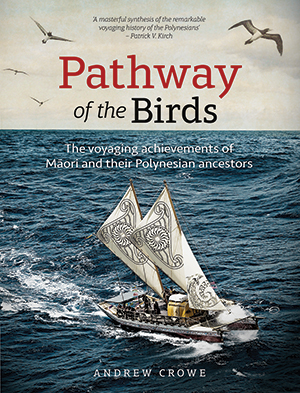 When I heard that Andrew Crowe was the author of a new book about Polynesian voyaging, I must admit that I was both surprised and intrigued. I am a fan of many of his books about New Zealand plants and birds, and therefore I immediately connected the reference to birds in the title of this book with his previous works. With keen interest I embarked on the journey of reading this well-presented book, drawn in by the image of a modern waka hourua on the cover, and backed up by the fantastic and helpful reference map of the Pacific on the inside sleeve.
When I heard that Andrew Crowe was the author of a new book about Polynesian voyaging, I must admit that I was both surprised and intrigued. I am a fan of many of his books about New Zealand plants and birds, and therefore I immediately connected the reference to birds in the title of this book with his previous works. With keen interest I embarked on the journey of reading this well-presented book, drawn in by the image of a modern waka hourua on the cover, and backed up by the fantastic and helpful reference map of the Pacific on the inside sleeve.
Pathway of the Birds is a great read. It skilfully traces the migration paths of our Polynesian tūpuna and highlights their mastery, ingenuity and determination in settling the great ocean of Kiwa. In doing so, it explores the depth and diversity of Polynesian islands and people, presents the most up-to-date research and findings about Polynesian origins and migration, and sheds light on the staggering extent of population and cultural loss suffered by Polynesians following contact with European nations. All of this is aided by wonderful images, first-hand experiences, and the widespread use of maps showing the distribution of key words, including place and species names, that highlight the connection and migration paths across the Pacific.
Crowe also pulls together an amazing diversity of sources and information – from linguistics, archaeology, and genetics; as well as the ecological, botanical, and ornithological knowledge he is best known for, to bring recognition to the outstanding feats of Polynesian exploration, and to debunk the myths of accidental discovery. He outlines clear evidence of return voyaging, as well as regular inter-island contact between New Zealand and central Polynesia, and the process of strategic discovery voyaging followed by planned settlement voyaging. Crowe also provides explanations for the origins and spread of kūmara, why widespread Polynesian voyaging ceased, and why certain species were not brought to Aotearoa. Finally, he reveals his compelling thesis of the significance of a pathway of birds that helped guide Polynesian navigators towards Aotearoa.
The only thing I felt was missing from the book was reference and commentary on the contemporary leaders of Polynesian voyaging such as Nanoa Thompson, Hekenukumai Busby, Mātahi Whakataka-Brightwell, and Hoturoa Kerr; as well as the pivotal role of Micronesian expert Mau Piailug in the revitalisation of the very thing the book is promoting. This recognition would have brought the book full circle and acknowledged the living and breathing spirit of the Polynesian culture. It was great, however, to note two Ngāi Tahu experts referenced throughout the book – Atholl Anderson and Matiu Prebble!
I recommend Pathway of the Birds to anyone with a passion for understanding our Polynesian origins and heritage and furthering their knowledge of the voyaging skills and feats of our tūpuna.
 Craig Pauling (Ngāi Tahu – Ngāi Te Ruahikihiki, Ngāi Tūāhuriri and Ngāti Mutunga) leads the Te Hīhiri Cultural Advisory Team at New Zealand-owned environmental design and planning consultancy Boffa Miskell, and previously worked in the Kaupapa Taiao Team at Te Rūnanga o Ngāi Tahu. Craig has a passion for the protection and promotion of mahinga kai and is also heavily involved in waka ama and reviving all forms of traditional canoeing. He lives in Ōtautahi with his wife Janyne (Nō Ngāti Waewae), and their three tamariki Mihiroa, Meihana and Tainui.
Craig Pauling (Ngāi Tahu – Ngāi Te Ruahikihiki, Ngāi Tūāhuriri and Ngāti Mutunga) leads the Te Hīhiri Cultural Advisory Team at New Zealand-owned environmental design and planning consultancy Boffa Miskell, and previously worked in the Kaupapa Taiao Team at Te Rūnanga o Ngāi Tahu. Craig has a passion for the protection and promotion of mahinga kai and is also heavily involved in waka ama and reviving all forms of traditional canoeing. He lives in Ōtautahi with his wife Janyne (Nō Ngāti Waewae), and their three tamariki Mihiroa, Meihana and Tainui.
Helen and the Go-Go Ninjas
Nā Ant Sang rāua ko Michael Bennett
Penguin 2018
RRP $30.00
Review nā Madison Henry Ryan
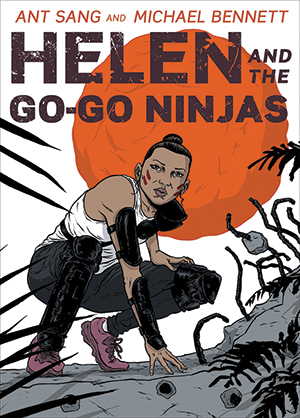 Helen and the Go-Go Ninjas is a witty and energetic buzz-collaboration between Ant Sang and Michael Bennett.
Helen and the Go-Go Ninjas is a witty and energetic buzz-collaboration between Ant Sang and Michael Bennett.
This story is another win for the Aotearoa graphic novella scene. There are elements of Kiwi culture integrated into this steampunk sci-fi thriller, which manages to bend time and space with its vibrant, action-packed journey.
With its clashing elements of time travel and cyber-punk ninjas battling orbs of light, the story can seem like a rehash of science fiction tropes. However, being set in a New Zealand context somehow brings it closer to home.
I would say this artful journey is the perfect gift for a youth and even adults keen to get lost in another world for an hour or so. Visually there are some great moods created using neon highlights and dramatic shading. The overall plot moves along at a fast pace, with explosive moments and witty plot twists.
There are some dark nods towards abusive relationships and segregation between men and women which I wasn’t a fan of; but I also found myself finding similarities to other pop culture references, like Pocahontas meets George Pal’s film, The Time Machine (1960).
Michael Bennett’s screenwriting influence reveals itself through a cinematic storytelling lens that keeps you guessing. Although the pacing may seem too fast, the story weaves together everything from an Amazonian tree woman to futuristic colts battling time-travelling Kiwi ninjas. Michael (Ngāti Pikiao, Ngāti Whakaue) is an award-winning New Zealand screenwriter and author whose films have been selected for numerous film festivals including Cannes, Berlin, Toronto, and New York.
This novella is of course also expressed via Ant Sang’s dope artistic vision. He is known for his previous graphic novels The Dharma Punks (2001) and Shaolin Burning (2011), but is perhaps more widely known for his work as head designer for the characters in the animated TV series Bro’Town (2004–2009), for which he won multiple awards.
Helen and the Go-Go Ninjas is a competent and distinctively creative story with panels bursting with vivid aesthetics and intriguing ideas. I highly rate how Sang and Bennett have weaved a good variety of themes into this world. I was able to finish the story in under an hour during a flight, and thereafter gifted the book to another young man in Ōrewa, to get inspired and pay it forward.
I’m looking forward to checking out future stories in the Aotearoa G-novel scene. I believe we have a growing platform in Aotearoa, with a lot of unique, free-minded thinkers, whether it be culture or self-expression. We have so many realms to delve into, and it’s creative pūrākau (stories) like this one that reminds us that there is no spoon.
 Madison Henry Ryan (Ngāi Tahu, Ngāti Māmoe, Waitaha, Ngāti Rarotonga) is a budding entrepreneur and the co-founder of Māui Studios who specialises in filmmaking and cultural design practice for Māori organisations and communities. He has a technical design background and works in a centre for social innovation alongside a network of peers and practitioners.
Madison Henry Ryan (Ngāi Tahu, Ngāti Māmoe, Waitaha, Ngāti Rarotonga) is a budding entrepreneur and the co-founder of Māui Studios who specialises in filmmaking and cultural design practice for Māori organisations and communities. He has a technical design background and works in a centre for social innovation alongside a network of peers and practitioners.
Mountains to Sea: Solving New Zealand’s Freshwater Crisis
Edited by Mike Joy
Bridget Williams Books 2018
RRP $14.99
Review nā Rata Pryor-Rodgers
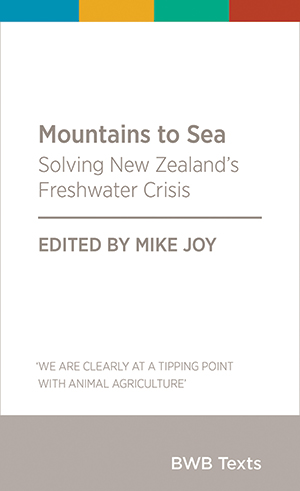 Mountains to Sea: Solving New Zealand’s Freshwater Crisis is a short book that looks at the freshwater crisis we are faced with, its causes, and possible solutions. Its editor, Dr Mike Joy, is one of New Zealand’s leading freshwater ecologists. The authors are experts in fields including food production, water storage, contaminants, public health, and economics.
Mountains to Sea: Solving New Zealand’s Freshwater Crisis is a short book that looks at the freshwater crisis we are faced with, its causes, and possible solutions. Its editor, Dr Mike Joy, is one of New Zealand’s leading freshwater ecologists. The authors are experts in fields including food production, water storage, contaminants, public health, and economics.
The introduction to the kaupapa of this book comes from Tina Ngata, who acquaints us with the whakapapa of water and why it is considered a taonga by Māori. This, and the chapters that follow, are very readable, easy to digest, and look at different areas of the freshwater crisis.
One characteristic I really liked was that the book turns the conversation away from the cost to the farmers of x, y, or z actions; instead highlighting the cost to the environment of not acting. It often reframed the conversation to assess what the cost to the environment and ecosystem would be if you want to undertake a certain activity. For example, if you want to discharge one kilogram of nitrogen, it will impact the waterways in this manner and cost x amount to remove it.
I appreciated that the book did not solely focus on the problems we have in freshwater. Each author offered some kind of solution to the seemingly overwhelming issues we are facing. These solutions had a strong imperative in common: the need to reduce animal agriculture and de-intensify our food production.
Mike Joy explains that achieving this could reduce excess nutrients, excess sediment, habitat loss, soil, water, and groundwater contamination, and the overall degradation of the mauri of the waterways. It will also decrease New Zealand’s greenhouse gas production, which will help mitigate climate change.
The need for the environment to come first and foremost is becoming more prevalent in our everyday lives. We are currently witnesses to the result of the economy taking priority – we can see it, smell it, and taste it in our waters. Given that the Ngāi Tahu takiwā holds more than 60 percent of New Zealand’s surface water, more than 80 per cent of its groundwater, 70 per cent of wetland extent, and some of the highest amounts of allocated water in the country, it’s hard not to get down at times looking at the state of some of our awa, roto, hāpua, and puna. But when you start thinking about the solution given in this book and what it could mean for many of our waterways, it does provide a little bit of excitement for what the future can hold.

Rata Pryor-Rodgers (Ngāi Tahu, Kāti Māmoe) grew up in Paekākāriki. She works as a Policy Advisor in the Strategy and Influence team at Te Rūnanga o Ngāi Tahu. Freshwater is a key focus of her mahi.
Go Girl – A Storybook of Epic NZ Women
Nā Barbara Else
Penguin 2018
RRP $45.00
Oh Boy – A Storybook of Epic NZ Men
Nā Stuart Lipshaw
Penguin 2018
RRP $45.00
Reviews nā Hineātea (10) rāua ko Tūnui Alexander (8)
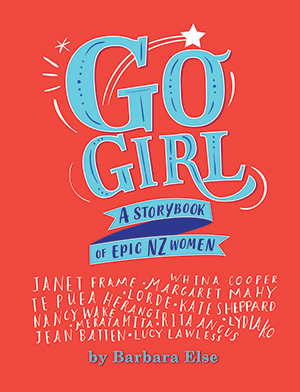 Go Girl and Oh Boy are companion volumes for children, each featuring a collection of short biographies of New Zealand women and men respectively. Hineātea and Tūnui reviewed these pukapuka with the help of their māmā, Awhina McGlinchey.
Go Girl and Oh Boy are companion volumes for children, each featuring a collection of short biographies of New Zealand women and men respectively. Hineātea and Tūnui reviewed these pukapuka with the help of their māmā, Awhina McGlinchey.
Hineātea read Go Girl and enjoyed reading stories about epic New Zealand women ranging from Ahumai Te Paerata, who led women in battle at Ōrākau during the Māori Land Wars, to Lydia Ko, the youngest person to rank No.1 internationally in professional golf.
“What I think is great about this book is that it is all about amazing women from New Zealand. It gives me strong role models who have grown up in the same country as me, including a few who are not even that much older than me. It celebrates wāhine toa who have achieved great things, and the many different talents they possess.
“I would have appreciated a more detailed description of each of these mega-magnificent people as I found the biographies to be quite short. However, it is a good starting point for young girls to see what girl power can do!”
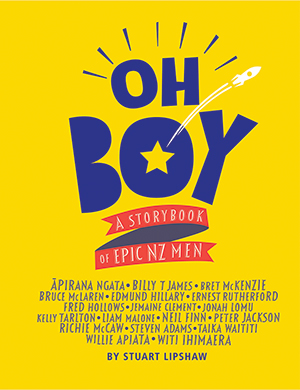 Tūnui read Oh Boy, which is made up of biographies of New Zealand men including Kupe, the first Polynesian explorer to discover Aotearoa, and Steven Adams, professional basketball player for the Oklahoma City Thunder.
Tūnui read Oh Boy, which is made up of biographies of New Zealand men including Kupe, the first Polynesian explorer to discover Aotearoa, and Steven Adams, professional basketball player for the Oklahoma City Thunder.
“I like that this book has men who have done amazing things in so many different areas, like explorers, scientists, artists, and sportsmen, as well as lots more. It is inspiring to read about the different things these men have done, all of them from New Zealand. I particularly like to look at the timeline to see when these people were alive.
“I believe this book is perfect for 8–10 year olds to read by themselves and be proud of the Epic New Zealand men in the book.”
 Hineātea (10) and Tūnui (8) Alexander are Ngāi Tahu tamariki that whakapapa to Moeraki. They live in Ōtautahi in an intergenerational home with their māmā Awhina, as well as their taua and pōua, Rangi and Trevor McGlinchey.
Hineātea (10) and Tūnui (8) Alexander are Ngāi Tahu tamariki that whakapapa to Moeraki. They live in Ōtautahi in an intergenerational home with their māmā Awhina, as well as their taua and pōua, Rangi and Trevor McGlinchey.
Government for the Public Good: The Surprising Science of Large-Scale Collective Action
Nā Max Rashbrooke
Bridget Williams Books 2018
RRP $49.99
Review nā Gerry Te Kapa Coates
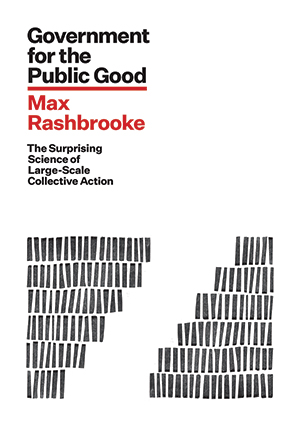 In a world of increasing change and division and less stable leadership, it is good to have a very readable book about how governments could or should work. As the author, Max Rashbrooke, says, “… there are many important things that governments can do that no other body can”. Rashbrooke cites healing the hole in the ozone layer as one example. He also states that “letting markets take care of more things has not in many cases worked very well”, in reference to the biggest recent failure, the Global Financial Crisis. Another quote from the author states that “although governments have often delivered well, they still have to fix significant weaknesses if they are to regain the public’s trust.”
In a world of increasing change and division and less stable leadership, it is good to have a very readable book about how governments could or should work. As the author, Max Rashbrooke, says, “… there are many important things that governments can do that no other body can”. Rashbrooke cites healing the hole in the ozone layer as one example. He also states that “letting markets take care of more things has not in many cases worked very well”, in reference to the biggest recent failure, the Global Financial Crisis. Another quote from the author states that “although governments have often delivered well, they still have to fix significant weaknesses if they are to regain the public’s trust.”
Rashbrooke is particularly focused on the “Anglosphere” – for example, Australia, Canada, Ireland, New Zealand, the UK, and the US. He also spends some time mentioning Scandinavian governments, which are good innovators in areas such as humanising prisons.
He points out that democratic governments “do not work alone”, and rely on a free press and an active civil society. They also cover everyone who is a citizen within a given territory.
My own particular interest is in governments where there is an indigenous minority such as Māori. Rashbrooke mentions the 19th century British philosopher John Stuart Mill’s idea “that only advanced people were fit for democracy”, and that the “barbarous or semi-barbarous” societies, such as those Britain had colonised, must be ruled by enlightened despots until they became more civilised. Later, Rashbrooke notes that “most Anglosphere administrations are founded on the colonisation of indigenous cultures” that “stripped away traditional forms of government and their distinctive ways of settling disputes, allocating resources, and distributing power.”
Rashbrooke could also have mentioned land alienation and the associated rights reductions that followed. Sadly, that is almost all the coverage the topic of colonisation gets; although it arises in many Anglosphere countries. Later he quotes Roald Dahl when he says that “the Anglosphere’s liberal democracies have always been an ‘uneasy synthesis of majority rule and minority rights.’”
The author also points out that it is “not a given that governments will correctly identify the public good”, nor that they will “consult widely and give the otherwise marginalised a greater voice”, if influential groups – such as immigrant settlers – want to use their government for their own ends. He also points out that “government itself is a centre of power open to abuse”, but consoles us by saying “that power is at least subject to democratic sanction”; which is true if there is not a majority-rules ethic. Even today Māori are still referred to as “stakeholders”, rather than Treaty partners. Democracy can be a long time coming.
The Nobel Prize-winner Amartya Sen posed the question of whether people can lead lives they have reason to value – a question expanded on by feminist philosopher Martha Nussbaum, who suggested that “capabilities were more useful than rights”, as for example set out in the UN’s Universal Declaration of Human Rights adopted in 1948. The author sees governments as having seven tasks to focus on: law and order, protecting the planet, urban planning, organising infrastructure, health and education, redistributing income and wealth, and managing the economy – all of which can cause “heated conflicts about the roles of governments and markets.”
Rashbrooke sums up by saying “greater democracy and greater equality are both prerequisites for a better future.” This could be a great book to renew the debate as to where democracy could or should go, and what needs to be fixed on the way. All together this is a well-presented easy read with apposite quotes from other experts in the field.
 Gerry Te Kapa Coates (Ngāi Tahu, Waihao) was born in Ōāmaru, and has had poems, book, and theatre reviews and stories in Huia Short Stories collections 4, 5, and 7; and other publications including Landfall, Mana magazine and Ora Nui 3, as well as a wide variety of non-fiction espousing environmental issues, amongst other themes. His collection of poems and short stories from 1961–2011, The View From Up There, was published by Steele Roberts. Gerry was a panellist at the 2013 Christchurch Writers and Readers Festival. He also works as a consultant and commissioner on RMA and similar EPA hearings, as well as being an author and doing Māori and technology advisory work.
Gerry Te Kapa Coates (Ngāi Tahu, Waihao) was born in Ōāmaru, and has had poems, book, and theatre reviews and stories in Huia Short Stories collections 4, 5, and 7; and other publications including Landfall, Mana magazine and Ora Nui 3, as well as a wide variety of non-fiction espousing environmental issues, amongst other themes. His collection of poems and short stories from 1961–2011, The View From Up There, was published by Steele Roberts. Gerry was a panellist at the 2013 Christchurch Writers and Readers Festival. He also works as a consultant and commissioner on RMA and similar EPA hearings, as well as being an author and doing Māori and technology advisory work.
Opinions expressed in REVIEWS are those of the writers and are not necessarily endorsed by Te Rūnanga o Ngāi Tahu.